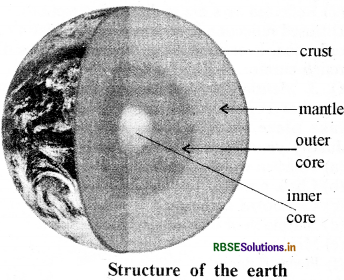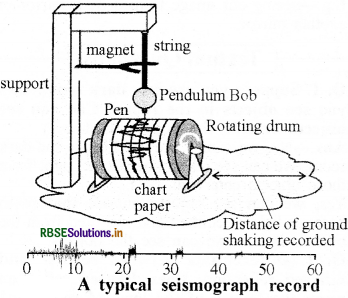RBSE Class 8 Science Important Questions Chapter 15 Some Natural Phenomena
Rajasthan Board RBSE Class 8 Science Important Questions Chapter 15 Some Natural Phenomena Questions and Answers.
RBSE Class 8 Science Chapter 15 Important Questions Some Natural Phenomena
Objective Questions
Question 1.
A charged glass rod and a charged plastic straw, will
(a) Attract each other
(b) Repel each other
(c) Neither attract, nor repel
(d) None of the above
Answer:
(a) Attract each other

Question 2.
In which part of India, came a massive earthquake on 26th January, 2001?
(a) North Kashmir
(b) Central Himalaya
(c) Bhuj, Gujarat
(d) Thar, Rajasthan
Answer:
(c) Bhuj, Gujarat
Question 3.
If on Richter scale, an earthquake measures 7, then it is:
(a) Weak earthquake
(b) Medium earthquake
(c) Destructive earthquake
(d) Not considered an earthquake
Answer:
(c) Destructive earthquake
Question 4.
Fault zone of India is:
(a) Kashmir valley
(b) Western and Central Himalayas
(c) North - Eastern States
(d) All of the above
Answer:
(d) All of the above
Question 5.
Lightning conductors are used for:
(a) Protecting man
(b) Protecting big buildings
(c) Protecting water sources
(d) Protecting birds
Answer:
(b) Protecting big buildings
Fill in the blanks
1. When ...................... move, then electric current is said to flow.
Answer:
charges
2. ...................... is caused due to disturbances deep down the earth’s crust.
Answer:
Earthquake
3. Like charges ...................... each other.
Answer:
repel

4. Charges are of ...................... types.
Answer:
two
True/False
Write ‘T’ for true and ‘F’ for false for the following Statements:
1. Unlike charges attract each other.
Answer:
True
2. Some objects can be charged by rubbing them to other objects.
Answer:
True
3. Electric charges generated during rubbing acquires speed.
Answer:
False
4. Magnitude of thunderstorm can be expressed on Richter scale.
Answer:
False
Match the words given in 'Column-A with 'Column-B'
Question 1.
|
Column-A |
Column-B |
|
(i) Earthing |
(a) Earths' sudden shaking |
|
(ii) Electric discharge |
(b) Lightning due to accumulation of charge |
|
(iii) Earthquake |
(c) Process of transferring the charge to the earth |
|
(iv) Tsunami |
(d) Large and destructive wave in sea |
Answer:
|
Column-A |
Column-B |
|
(i) Earthing |
(c) Process of transferring the charge to the earth |
|
(ii) Electric discharge |
(b) Lightning due to accumulation of charge |
|
(iii) Earthquake |
(a) Earths' sudden shaking |
|
(iv) Tsunami |
(d) Large and destructive wave in sea |
Question 2.
|
Column-A |
Column-B |
|
(i) Electroscope |
(a) Water heater |
|
(ii) Lightning conductor |
(b) Seismic wave recording device |
|
(iii) Earthquake |
(c) Device to protect buildings from the effect of lightning |
|
(iv)Geyser |
(d) Device for identifying the charged objects |
Answer:
|
Column-A |
Column-B |
|
(i) Electroscope |
(d) Device for identifying the charged objects |
|
(ii) Lightning conductor |
(c) Device to protect buildings from the effect of lightning |
|
(iii) Earthquake |
(b) Seismic wave recording device |
|
(iv)Geyser |
(a) Water heater |
Question 3.
|
Column-A |
Column-B |
|
(i) Earthquake prone area |
(a) Fault zones |
|
(ii) Earthquake measuring scale |
(b) Decibel |
|
(iii) Sound intensity unit |
(c) Hertz |
|
(iv) Frequency measuring unit |
(d) Richter scale |
Answer:
|
Column-A |
Column-B |
|
(i) Earthquake prone area |
(a) Fault zones |
|
(ii) Earthquake measuring scale |
(d) Richter scale |
|
(iii) Sound intensity unit |
(b) Decibel |
|
(iv) Frequency measuring unit |
(c) Hertz |
Very Short Answer Type Questions
Question 1.
Which type of charge is developed on glass rod when it is rubbed with silk? What are these charges called?
Answer:
On rubbing glass rod with a silk cloth, glass rod acquires a positive charge. This charge is called static charge.

Question 2.
What type of force is developed on bringing a positively charged object near another positively charged object?
Answer:
Repelling force.
Question 3.
What are electric conductors?
Answer:
The substances through which electric current flows conveniently from one part to the other are called conductors.
Question 4.
What do you understand by the process of charging?
Answer:
The property of attraction developed in a metal when two metals are rubbed together, when brought near each other or when brought in contact with each other is due to charging of the bodies.
Question 5.
When two balloons are rubbed with a woollen cloth and brought near each other, what happens?
Answer:
They repel each other because both balloons acquire identical charges due to rubbing.
Question 6.
Name the scale that measures the intensity of earthquake.
Answer:
'Richter Scale' measures the intensity of earthquake.
Question 7.
What is lightning?
Answer:
Lightning is an electric spark on a large scale.
Question 8.
What do you mean by earthing?
Answer:
When charge of a charged object is transferred to the earth, it is called Earthing.
Question 9.
What are fault zones?
Answer:
The boundaries of earth’s plates have a higher probability to experience an earthquake. These areas are called fault zones.
Question 10.
What is the reason for an earthquake?
Answer:
An earthquake is caused due to disturbance deep down inside the upper most layer of the earth's crust.
Short Answer Type Questions
Question 1.
When a comb combs dry hair then it attracts small pieces of paper that are bad conductors. What will happen if the hair are wet ?
Answewr:
Due to friction, the comb gets electrically charged and attracts small pieces of paper because atoms of paper gets polarised by the comb as a result of which, atomic attraction develops. When hair are wet, there is less friction between comb and hair due to which the comb is not charged and does not attract small pieces of paper.

Question 2.
Explain the process of electrical discharge.
Or
How is thunderstorm developed?
Answer:
During the formation of thunderstorms, the air currents move upward while tiny water droplets move downward. Due to this upward and downward movements charges are separated. By certain process the upper edge of clouds acquire a positive charge whereas the lower edge acquires a negative charge. Similarly the surface of earth is positively charged.
When the amount of these charges become very large the air which is usually an insulator becomes conducting. Negative and positive charges move towards each other and produce streaks of light and also the sound. This is termed as lightning and this process is known as ‘Electric Discharge’. This process can take place between two or more clouds as well as between clouds and earth.
Question 3.
Explain any three ways to protect ourselves from lightning when inside the house.
Answer:
- During the thunderstorm, one should not touch telephone wires, electricity wires and metal pipes.
- One should not bathe during thunderstorm to prevent contact with flowing water.
- The plugs of computer, TV, etc. electric appliances should be removed from the sockets.
Question 4.
What is lightning conductor? How does it protect buildings from the effect of lightning?
Answer:
Lightning conductor is a device that can be used to protect high buildings from ligthning effect. During construction of a building a metal (preferably copper) rod with a height more than that of the building is fixed in the walls.
One end of this rod is open to the wind while the other is situated deep inside the earth. The metal rod during a thunderstorm provides a simple way to transfer charges to earth without any damage to the building.
Question 5.
What is an earthquake? Write.
Answer:
Earthquake, that remains active for a short period, is a tremor or shaking of the earth. It takes place due to disturbance deep inside the earth’s crust. Earthquakes frequently occur everywhere usually they’re not noticed.
Large earthquakes are very rare. They destroy bridges, dams and mankind. They can cause immense damage to life and property. They can also cause flood, landslide and tsunami.
Question 6.
What is the measure of intensity of an earthquake?
Answer:
Intensity of an earthquake is measured in terms of Richter Scale. Earthquakes that measure upto 3 on Richter scale are very weak and do not cause any harm. Sometimes they are not even felt. But earthquakes of measure more than 7 on Richter scale are very destructive and destroy entire village or city.
Question 7.
If you’re inside the home, what precautions will you take to protect yourselves from an earthquake?
Or
Which precautions should be used to protect yourself when you are at home at the time of strike of earthquake?
Answer:
- Take shelter under a table and stay there until tremors stop.
- Stay away from high and heavy objects that can fall on you.
- If you’re sitting on bed. don’t get up. Protect your head using a pillow.
Question 8.
Draw a labelled diagram of structure of earth.
Answer:

Essay Type Questions
Question 1.
How does an earthquake occur? Elaborate.
Answer:
Mainly earthquake develops due to movement of earth’s plates. Earth's crust is divided into many parts. Each part is known as a plate. These plates are constantly moving. When they collide with each other or the plates move over one another, a disturbance is developed in the earth's crust.
This disturbance is seen as an earthquake on earth's crust. Where boundaries of plates are weak. probability of an earthquake is more. These weak zones are called seismic zones or fault zones.
The other reasons for earthquake are:
- volcanic eruption
- when a meteor hits the earth
- underground nuclear explosion etc.
Question 2.
What should one do to protect oneself from an earthquake?
Answer:
We should adopt following ways for protection against earthquake:
- Design of buildings should be such that they can tolerate major tremors. It is advisable to make the structure simple so that the structure is ’Quake Safe'.
- In highly seismic areas, instead of heavy construction material, mud or timber may be used. In case structure falls, the damage will not be heavy.
- Cupboards and shelves are fixed to the w alls, so that they don’t fall easily.
- Be careful while hanging wall clocks, photo - frames, water heaters etc. So in the event of an earthquake, they should not fall on people.
- Since some buildings may catch fire due to an earthquake, it is necessary that all buildings, especially tall ones, have fire fighting equipments in working order. Fire fighting equipments should be tested periodically.
- Consult qualified architect and structure engineer.

Question 3.
Draw a labelled diagram of a seismograph and explain it.
Answer:
The tremors produce waves on the surface of the earth. These are called seismic

waves. The waves are recorded by an instrument called the seismograph. The instrument is simply a vibrating rod or a pendulum, which starts vibrating when tremor occur. A pen is attached to the vibrating system. The pen moves on a paper that moves under it and records the seismic waves. By studying these waves, scientists can construct a complete map of the earthquake.
